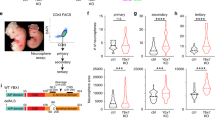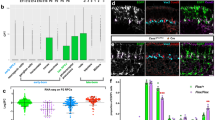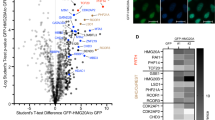Abstract
Neurulation is a complex process of histogenesis involving the precise temporal and spatial organization of gene expression1,2. Genes influencing neurulation include proneural genes determining primary cell fate, neurogenic genes involved in lateral inhibition pathways and genes controlling the frequency of mitotic events. This is reflected in the aetiology and genetics of human and mouse neural tube defects, which are of both multifactorial and multigenic origin3. The X-linked gene Nap1l2, specifically expressed in neurons, encodes a protein that is highly similar to the nucleosome assembly (NAP) and SET proteins. We inactivated Nap1l2 in mice by gene targeting, leading to embryonic lethality from mid-gestation onwards. Surviving mutant chimaeric embryos showed extensive surface ectoderm defects as well as the presence of open neural tubes and exposed brains similar to those observed in human spina bifida and anencephaly. These defects correlated with an overproduction of neuronal precursor cells. Protein expression studies showed that the Nap1l2 protein binds to condensing chromatin during S phase and in apoptotic cells, but remained cytoplasmic during G1 phase. Nap1l2 therefore likely represents a class of tissue-specific factors interacting with chromatin to regulate neuronal cell proliferation.
This is a preview of subscription content, access via your institution
Access options
Subscribe to this journal
Receive 12 print issues and online access
$209.00 per year
only $17.42 per issue
Buy this article
- Purchase on Springer Link
- Instant access to full article PDF
Prices may be subject to local taxes which are calculated during checkout






Similar content being viewed by others
References
Kerszberg, M. & Changeux, J.-P. A simple molecular model of neurulation. Bioessays 20, 758–770 (1998).
Wilson, P.A. & Hemmati-Brivanlou, A. Vertebrate neural induction: inducers, inhibitors, and a new synthesis. Neuron 18, 699–710 (1997).
Emery, A.E.H. in Methodology in Medical Genetics 58 (Churchill Livingstone, Edinburgh, 1986).
Altman, R. & Kellog, D. Control of mitotic events by Nap1 and Gin4 kinase. J. Cell Biol. 138, 119–130 (1997).
Simon, H.U. et al. Molecular characterization of hNRP, a cDNA encoding a human nucleosome-assembly-protein-I-related gene product involved in the induction of cell proliferation. Biochem. J. 297, 389–397 (1994).
Laskey, R.A., Honda, B.M., Mills, A.D. & Finch, J.T. Nucleosomes are assembled by an acidic protein which binds histones and transfers them to DNA. Nature 275, 416–420 (1978).
McQuibban, G.A., Commisso-Cappelli, C.N. & Lewis, P.N. Assembly, remodeling, and histone binding capabilities of yeast nucleosome assembly protein 1. J. Biol. Chem. 273, 6582–6590 (1998).
Ito, T., Bulger, M., Kobayashi, R. & Kadonaga, J.T. Drosophila NAP-1 is a core histone chaperone that functions in ATP-facilitated assembly of regularly spaced nucleosomal arrays. Mol. Cell. Biol. 16, 3112–3124 (1996).
Rodriguez, P. et al. Functional characterization of human nucleosome assembly protein-2 (NAP1L4) suggests a role as a histone chaperone. Genomics 44, 253–265 (1997).
Kellogg, D.R., Kikuchi, A., Fujii-Nakata, T., Turck, C.W. & Murray, A.W. Members of the NAP/SET family of proteins interact specifically with B-type cyclins. J. Cell Biol. 130, 661–673 (1995).
Rougeulle, C. & Avner, P. Cloning and characterization of a murine brain specific gene Bpx and its human homologue lying within the Xic candidate region. Hum. Mol. Genet. 5, 41–49 (1996).
Fraichard, A. et al. In vitro differentiation of embryonic stem cells into glial cells and functional neurons. J. Cell Sci. 108, 3181–3188 (1995).
Struebing, C. et al. Differentiation of pluripotent embryonic stem cells into the neuronal lineage in vitro gives rise to mature inhibitory and excitatory neurons. Mech. Dev. 53, 275–287 (1995).
McBurney, M.W. P19 embryonal carcinoma cells. Int. J. Dev. Biol. 37, 135–140 (1993).
Naruse, I. & Keino, H. Apoptosis in the developing CNS. Prog. Neurobiol. 47, 135–155 (1995).
Khochbin, S. & Wolffe, A.P. Developmentally regulated expression of linker-histone variants in vertebrates. Eur. J. Biochem. 225, 501–510 (1994).
Reyes, J.C. et al. Altered control of cellular proliferation in the absence of mammalian brahma (SNF2α). EMBO J. 17, 6979–6991 (1998).
Ishibashi, M. et al. Targeted disruption of mammalian hairy and Enhancer of split homolog-1 (HES-1) leads to up-regulation of neural helix-loop-helix factors, premature neurogenesis, and severe neural tube defects. Genes Dev. 9, 3136–3148 (1995).
Wilson, D.B. Proliferation in the neural tube of the Splotch (Sp) mutant mouse. J. Comp. Neurol. 154, 249–256 (1974).
Jensson, O. et al. A family showing apparent X linked inheritance of both anencephaly and spina bifida. J. Med. Genet. 25, 227–229 (1988).
Neumann, P.E. et al. Multifactorial inheritance of neural tube defects: localization of the major gene and recognition of modifiers in ct mutant mice. Nature Genet. 6, 357–362 (1994).
Copp, A.J., Checiu, I. & Henson, J.N. Developmental basis of severe neural tube defects in the loop-tail (Lp) mutant mouse: Use of microsatellite DNA markers to identify embryonic genotype. Dev. Biol. 165, 20–29 (1994).
Young, W.S. 3d, Bonner, T.I. & Brann, M.R. Mesencephalic dopamine neurons regulate the expression of neuropeptide mRNAs in the rat forebrain. Proc. Natl Acad. Sci. USA 83, 9827–9831 (1986).
Le Novère, N., Zoli, M. & Changeux, J.P. Neuronal nicotinic receptor alpha 6 subunit mRNA is selectively concentrated in catecholaminergic nuclei of the rat brain. Eur. J. Neurosci. 8, 2428–2439 (1996).
Rougeulle, C., Colleaux, L., Dujon, B. & Avner, P. Generation and characterization of an ordered λ clone array for the 460-kb region surrounding the murine Xist sequence. Mamm. Genome 5, 416–423 (1994).
Gardner, R.L. Mouse chimeras obtained by the injection of cells into the blastocyst. Nature 220, 596–597 (1968).
Wood, S.A. et al. Simple and efficient production of embryonic stem cell-embryo chimeras by coculture. Proc. Natl Acad. Sci. USA 90, 4582–4585 (1993).
Nagy, A., Rossant, J., Nagy, R., Abramow-Newerly, W. & Roder, J.C. Derivation of completely cell culture-derived mice from early-passage embryonic stem cells. Proc. Natl Acad. Sci. USA 90, 8424–8428 (1993).
Papenbrock, T. et al. Murine Hoxc-9 gene contains a structurally and functionally conserved enhancer. Dev. Dyn. 12, 540–547 (1998).
Hogan, B., Beddington, R., Costantini, F. & Lacy, E. in Manipulation of the Mouse Embryo 373–375 (Cold Spring Harbor Laboratory Press, New York, 1994).
Acknowledgements
We thank Y. Gong for technical assistance; C. Rougeulle for DNA probes; M. Cohen-Tannoudji for the lacZneo cassette; A. Copp and P. Stanier for comments concerning the mutant phenotypes; A. Prochiantz and D. Riethmacher for advice on antibodies; and E. Heard for critical reading of the manuscript. U.C.R. has been supported by grants from the Deutsche Forschungsgemeinschaft, the AFM and the EEC (contract no. BMH4-CT98-5072). D.D.S. was supported for this research by URRF Gene Targeting/Knockout Mouse Facility funding. N.L. was financed by the Ministère de la Recherche et de l'Enseignement, AFM and the Pasteur Institute J.P.C. was supported by the Collège de France and AFM.
Author information
Authors and Affiliations
Corresponding author
Rights and permissions
About this article
Cite this article
Rogner, U., Spyropoulos, D., Le Novère, N. et al. Control of neurulation by the nucleosome assembly protein-1–like 2. Nat Genet 25, 431–435 (2000). https://doi.org/10.1038/78124
Received:
Accepted:
Issue Date:
DOI: https://doi.org/10.1038/78124
This article is cited by
-
Ethionine-mediated reduction of S-adenosylmethionine is responsible for the neural tube defects in the developing mouse embryo-mediated m6A modification and is involved in neural tube defects via modulating Wnt/β-catenin signaling pathway
Epigenetics & Chromatin (2021)
-
TSPYL2 Regulates the Expression of EZH2 Target Genes in Neurons
Molecular Neurobiology (2019)
-
The histone chaperone NAP1L3 is required for haematopoietic stem cell maintenance and differentiation
Scientific Reports (2018)
-
A mechanistic role for the chromatin modulator, NAP1L1, in pancreatic neuroendocrine neoplasm proliferation and metastases
Epigenetics & Chromatin (2014)
-
NSBP-1 mediates the effects of cholesterol on insulin/IGF-1 signaling in Caenorhabditis elegans
Cellular and Molecular Life Sciences (2013)



